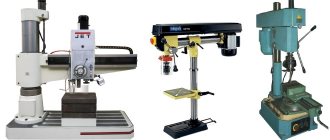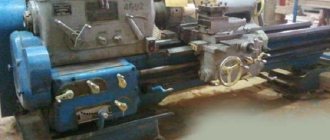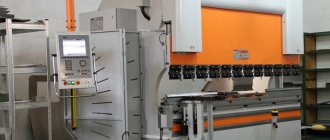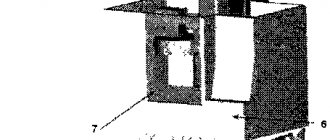Drilling machines can be classified as equipment with universal capabilities. At the same time with the ability to drill holes of various diameters, cleanliness and accuracy, with their help it is possible to perform numerous operations in accordance with the technological process of surface treatment. The use of this category of equipment is optimal if the technology provides for the following actions:
- drill, bore holes of various diameters;
- countersink the drilled holes to the appropriate parameters, countersink the necessary recesses to accommodate the protrusions of the fasteners;
- expand the surface of the holes within specified limits;
- roll out holes using ball and roller mandrels to a given level of roughness;
- perform internal thread cutting;
- trim (chase) the ends of parts in order to align them.
There are also other possibilities for using equipment in this category.
Rice. 1. Work performed on drilling machines
a – drilling; b – drilling; c – countersinking; g – countersinking; d – deployment; e – rolling; g – cutting internal threads; h – cutting (countering) the ends
Accessories for drilling machines
It doesn’t all end with the purchase of a drilling machine; in addition, it requires working equipment and devices for installing and fixing workpieces. It is recommended to buy everything you need together with the drilling equipment, so you can accurately and optimally assemble the required kit. Let's look at the composition of such a kit and other possible additional devices.
In addition, thrifty owners of drills and hammer drills may decide that a regular drill is suitable for use in a drilling machine, but standard cutting equipment is not always enough for the job.
Devices for fastening workpieces
An important point in metal cutting is the installation on the machine and fastening of the parts to be processed. Parts are installed on special devices, including:
- on a vice - machine, eccentric, screw, pneumatic;
- prism;
- squares;
- stops;
- conductors.
Depending on the speed and strength of fastening, manual (in small production) or pneumatic devices are selected, ensuring high speed of installation and fastening.
The most suitable for quick installation of workpieces are vices operating on the basis of a lever-cam mechanism. Clamping of the part between the movable and fixed jaws occurs due to the movement of the movable jaw, which is movably connected to a double cam and an eccentric roller. One movement of the handle in the horizontal direction achieves a rigid clamping of the part in the desired position.
Rice. 7. High-speed machine vice with lever-cam clamp: 1 – body; 2 – rotating part; 3 – fixed sponge; 4 – screw; 5 – sponge; 6 – handle; 7 – eccentric shaft; 8 – double cam; 9 - base
Conductors
An important device for precise centering of the axes of the tool and the hole being machined are jigs. The jig is installed above the part with a small gap to remove chips and is mounted on the machine table. In the body of the conductor there are holes, inside of which there are conductor bushings made of especially hard grades of steel that have undergone heat treatment (20X, U10A).
Rice. 8. Conductor bushings: a - permanent; b – quick-change
Permanent and quick-change bushings are used to ensure precise guidance of the cutting part of the tool in accordance with the specified parameters. There are special requirements for the distance between the workpiece and the jig, depending on the material being processed and the quality of the chips during processing. For cast iron parts, a gap of 0.3-0.5 from the diameter of the conductor bushing is assumed. The gap increases and can reach the diameter of the bushing if steel, copper and aluminum alloys, etc. are used as the material being processed.
The design of the conductor includes a body and a plate, which, depending on the purpose, can be:
- Removable (subject to replacement when changing workpiece parameters).
- Suspended, convenient when working with multi-spindle drilling heads. The hanging plate is placed on two rolling pin guides. The drilling head installed in the spindle of the machine is equipped with bushings that align with the upper ends of the rolling pins.
- Lifting ones, which move on rolling pins pressed into the conductor body using a pneumatic drive.
- Rotating (for ease of removal and installation of each subsequent part).
- Permanent (fixed in the conductor body using fasteners or welding).
Conductors significantly facilitate the work of workers, eliminating the preparatory work on marking and precise reinstallation of parts when performing operations on the equipment of the drilling group, ensuring the accuracy of the direction of the cutting tool. In accordance with the processing technology and production conditions, conductors of various designs are used, called:
- rotary.
- sliding.
- overturned.
- invoices.
The most common devices are overhead jigs, which are applied to the workpiece and fixed with metal fingers in a position that ensures the operation is performed in accordance with the technological map. The part is preliminarily fixed on the work table using an appropriate device that ensures the centering of the guide bushings of the jig with the axes of the holes drilled in the part. Conductors of this type can be mounted on a desktop (fixed), or installed on fixing fingers (unfixed).
Rice. 9. Unfastened overhead jig: 1 and 2 – fixing fingers; 3 – guide bushings; 4 – conductor plate; 5 – base surface of the device; 6 – holes
Rotary equipment
For the convenience of processing parts in accordance with the selected technology, appropriate rotary and movable equipment is used, which significantly facilitates the work without requiring reinstallation of parts for drilling or performing other operations for high-quality processing of holes. In such cases, it is assumed that special racks and tables will be used, including normalized, rotary and mobile ones. These are quite complex structures, which contain removable, including rotary, conductors. In this case, the conductors act as elements that guide the cutting tool during the corresponding operations. The main devices designed to move fixed workpieces on a machine in accordance with the requirements of the technological process are:
- rotary racks with a horizontal axis of rotation of the faceplate in which the workpieces are secured;
- rotary tables rotating around a vertical axis and located in a horizontal position.
Universal devices
Universal prefabricated devices (USP) are used when performing various metal cutting operations. USP are special devices that hold the workpiece in the position necessary to ensure precise machining of parts. Versatility lies in the ability to quickly install the workpiece, and, if necessary, to quickly retool the device.
An important device that provides the ability to perform several simultaneous or sequential operations on machine tools is multi-spindle drilling heads. These devices are used in large industries for drilling holes and their subsequent processing, which leads to a real acceleration of the process of manufacturing parts of complex configurations.
Turret drilling heads can contain a different number of spindles equipped with a cutting tool in accordance with a technological program that provides for sequential execution of operations. In this case, it is possible to set your own rotation speed for each spindle separately. In addition, the tool is fed at a certain speed in the forward and reverse directions. This head design makes it possible to operate and perform programmed operations without readjustment. Turret heads are provided with replaceable spindles with various design capabilities used in the technological process of cutting complex parts with the required accuracy and surface finish.
Rice. 10. Six-spindle turret: 1 – lock; 2 – lock lever; 3 – driving coupling half; 4 – clutch lever; 5 – main body; 6 – rod; 7, 8 – thrust screws; 9 – rack; 10 – gear; 11 – bevel gear; 12 – ratchet mechanism; 13 – serratus vein; 14 – rotary body; 15 – head spindle
The rotation and feeding of tools installed in each spindle is carried out in a programmed automatic mode, for this there is no need to stop the equipment for subsequent readjustment. Servicing machines with such complex devices requires highly qualified machine operators and technologists who develop the cutting process. The sequence of operations is carried out in accordance with the program: rotation of the head and feeding of the tool in the vertical direction is carried out in the required mode and compliance with the speed of rotation and feeding of the tools. After performing a certain operation, the head rises and rotates for the next operation.











